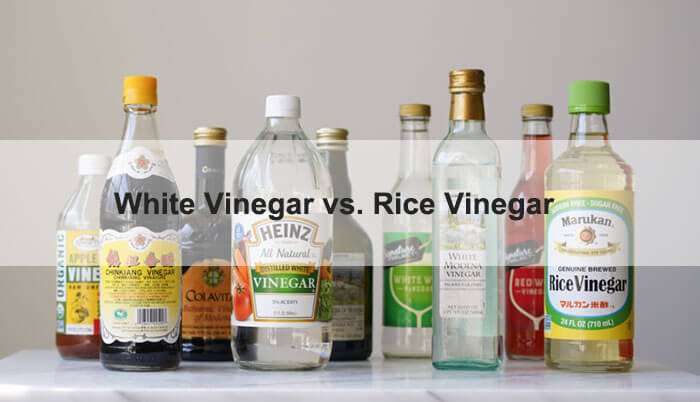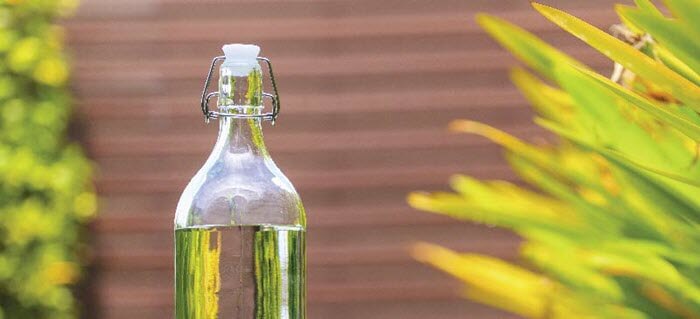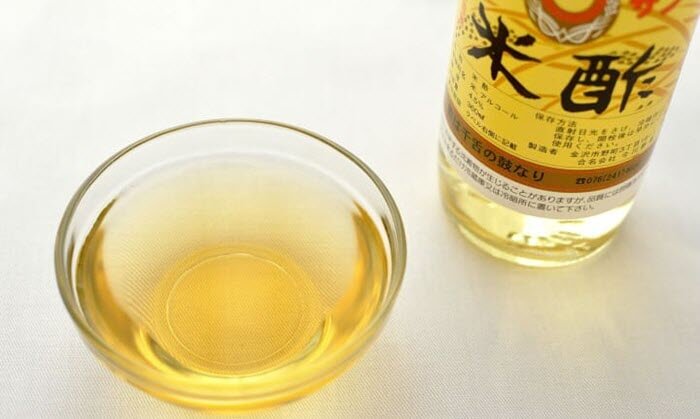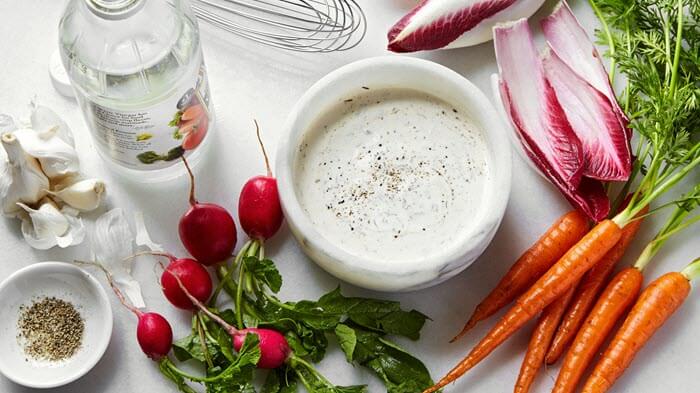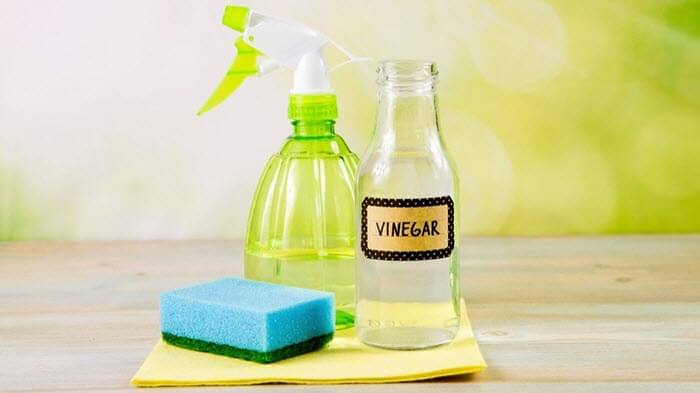Sometimes you might have a recipe that calls for rice vinegar, but you only have white vinegar in the pantry.
Or maybe you want to disinfect your kitchen counters, but all you have is rice vinegar on hand.
What happens when you substitute one for the other? Do they work the same?
Continue reading to learn more about white vinegar vs rice vinegar, and tips for cooking and cleaning with vinegar.
Table Of Contents
Is Rice Vinegar the Same as White Vinegar?
The short answer – no! They are different.
What is White Vinegar?
White or distilled vinegar is a pantry staple for many families. For household use, the white vinegar mixes 5-10% of acetic acid with 90-95% filtered water.
The acetic acid composition allows grain alcohol (ethanol) to ferment with yeast. The result of this process is crystal clear, pungent vinegar with many different home uses.
One thing you should note is that white vinegar is not white wine vinegar.
What is Rice Vinegar?
Rice vinegar is a popular, mild vinegar with a tangy and slightly sweet taste.
Produced by fermenting starch from glutinous rice with rice wine until the alcohol inside has reduced to acetic acid.
Rice vinegar usually has about 4% acetic acid to 96% water.
It is also often sold with a “seasoned” version that has added salt and sugar [1] for even more flavor.
White Vinegar vs Rice Vinegar for Cooking
Vinegar is one of the world’s oldest foods and has been used as a medicine, a cleaner, and to prevent food spoilage for thousands of years.
In modern times, both white vinegar and rice vinegar are usually easy to find at your local supermarket.
Rice vinegar’s mild flavor and a hint of sweetness make it an excellent addition to many recipes. It’s quite popular in many Asian dishes and leaves a smooth, tangy taste.
Rice vinegar truly shines when making:
- Stir-frys: If you’re aiming to make a stir-fry that is better than takeout, add a splash or two of rice vinegar to give it a bright, balanced flavor.
- Sauces: Liven up your sauces with a hint of rice vinegar, or skip the middleman and use the vinegar as the sauce itself—it’s excellent on fried fish and chips.
- Salad dressings: To make a healthy vinaigrette, mix your choice of oil and herbs with rice vinegar.
- Marinades: Adding rice vinegar to marinades will give your choice of protein a bright, balanced flavor
- Sushi rice: Mix rice vinegar with sushi rice to make authentic and flavorful sushi at home.
In contrast to rice vinegar’s mellow acidity, white vinegar’s clean but sharp flavor offers a much stronger kick.
Its bold taste can make it overpowering, so be careful to use it sparingly when cooking. Depending on your tastes, you can use white vinegar to make many of the same dishes as rice vinegar.
It is also particularly useful for:
- Pickling: From cucumbers to beets, dill or sweet, all pickles need acidic vinegar. White vinegar is a neutral starting point for every kind and flavor of a pickle.
- Baking: If your cake calls for buttermilk but you’re all out, you can add a splash of white vinegar to your regular milk for a similar effect. White vinegar also will react with baking soda, making it a useful leavening agent.
- Marinades: White vinegar can be a great addition to marinades or as a tenderizer. The acid in the vinegar helps to break down proteins in meat, making it more tender and flavorful.
- Homemade BBQ sauce: BBQ sauce is not known for its mild flavor, and white vinegar delivers the punch needed to balance out the sugar and spices.
Whatever your preference, there are many tasty and beneficial ways to use vinegar in your cooking.
Difference Between White and Rice Vinegar When Cleaning
The acid in vinegar makes it a versatile and effective cleaning agent. You can clean practically anything [2] with vinegar, but which type of vinegar is best?
When it comes to white vinegar vs rice vinegar for cleaning, white vinegar is the clear champion. It has higher acidity, is cost-effective and easy to buy in large quantities, and leaves no unwelcome residues.
You can use rice vinegar for cleaning too, but make sure it is plain and unseasoned. Added sugars will leave a sticky residue.
From disinfecting sprays to window cleaners, you can use vinegar to replace many of your chemical cleaning products.
Here are a few suggestions of how to use vinegar for cleaning different parts of your home.
Kitchen
- Refrigerator: Spray down the inside of your refrigerator with a 50/50 mixture of vinegar and water, then wipe clean.
- Microwave and oven: Use a microwave or oven-safe container with the same 50/50 mixture of vinegar and water, and heat it in your appliance. The steam and vinegar will help break down dried foods for easier cleaning.
- Countertops: Use vinegar spray to disinfect countertops and wipe clean. Be careful not to use vinegar on granite or marble, as the vinegar may damage the finish.
- Cutting boards: To disinfect your cutting boards, soak them in vinegar mixed with very hot water.
- Drains and garbage disposal: Spray vinegar down your drains and in your garbage disposal. Then dip a scrub brush in a dish of baking soda to clean away residue and odors.
Bathroom
- Toilet: For shining toilets, add a cup of vinegar to the bowl and leave it overnight. In the morning, add baking soda for extra cleaning power, scrub, and flush.
- Tub and Shower: Use hot vinegar to wipe down the tub and shower walls to remove soap scum and mildew. Soak your showerhead in vinegar to clear mineral buildup.
Floors
- Carpets: After a good shampoo, use vinegar to help rinse out leftover cleaning residue. Add about ½ cup of vinegar to each gallon of water in your carpet cleaner’s tank.
- Wood and laminate flooring: Combine ½ cup of vinegar to a gallon of hot water to eliminate dirt and germs from wood or laminate floors.
White Vinegar vs Rice Vinegar: The Verdict
Both kinds of vinegar can be tasty, useful, and substituted for one another if necessary.
Rice vinegar’s mildly sweet and mellow acidic flavor makes it excellent for cooking and very popular in Asian cuisine. You can use rice vinegar for cleaning, but white vinegar is better at getting the job done.
From cleaning toilets to pickling your favorite vegetables, white vinegar is a home workhorse with many uses.

